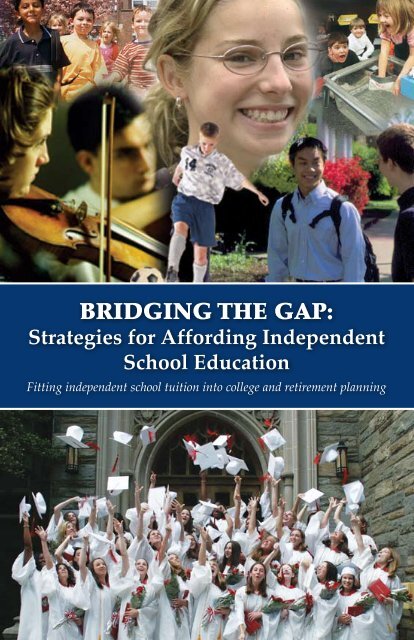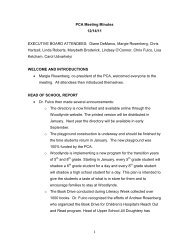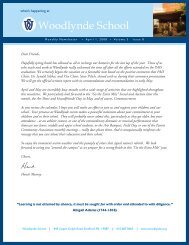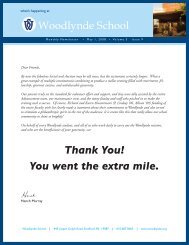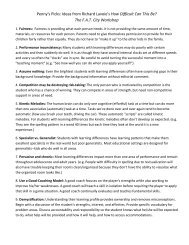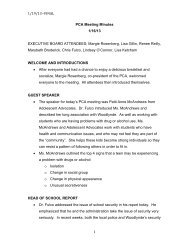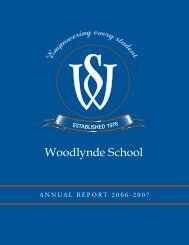ADVIS Financial Strategies - Woodlynde School
ADVIS Financial Strategies - Woodlynde School
ADVIS Financial Strategies - Woodlynde School
Create successful ePaper yourself
Turn your PDF publications into a flip-book with our unique Google optimized e-Paper software.
Bridging the Gap:<br />
<strong>Strategies</strong> for Affording Independent<br />
<strong>School</strong> Education<br />
Fitting independent school tuition into college and retirement planning
The Association of Delaware Valley<br />
Independent <strong>School</strong>s<br />
• Is a consortium of over 130 independent private schools in the<br />
tri-state area of Pennsylvania, Delaware, and New Jersey.<br />
• Supports and strengthens independent schools by providing<br />
top-notch, local professional development for school administrators,<br />
trustees and parents.<br />
• Member schools work together to inform parents, the media, policy<br />
makers, and the general public about independent education and to<br />
make their schools accessible to a wide range of families.<br />
Facts about <strong>ADVIS</strong> Member <strong>School</strong>s<br />
• Educate 57,000 students in pre-kindergarten through high school<br />
in the Greater Delaware Valley.<br />
• Employ over 13,000 faculty, administrators, and staff.<br />
• Have a combined annual budget in excess of $1,000,000,000.<br />
• Average school enrollment is 428.<br />
• Median class size is 16.<br />
• Average teacher/student ratio is 1:8.<br />
• 20% of enrolled students are students of color.<br />
• <strong>Financial</strong> aid is awarded to approximately 23% of all students.<br />
• In 2005-06 offered a combined $139,000,000 in need based<br />
financial aid.<br />
• Average financial aid grant in 2005-06 was $11,235.<br />
• 2005-06 Average Tuition Grades 1 & 3 Day = $13,251.<br />
• 2005-06 Average Tuition Grades 6 & 8 Day = $15,388.<br />
• 2005-06 Average Tuition Grades 9 & 12 Day = $17,530.<br />
DISCLAIMER: This booklet is not meant to be construed as legal, tax or financial advice.<br />
Neither <strong>ADVIS</strong> nor Melissa Diana provides any representations or warranties as to the use<br />
of the strategies contained herein. We recommend that you find and consult with a reputable<br />
tax and/or financial professional who is experienced with education planning before<br />
employing any of the strategies outlined in this booklet.<br />
Copyright © <strong>ADVIS</strong> 2007
INTRODUCTION<br />
Congratulations! — if you are reading this booklet, you already understand the<br />
lifelong value of independent school education and the difference it can make<br />
in your child’s life.<br />
The Association of Delaware Valley Independent <strong>School</strong>s (<strong>ADVIS</strong>) commends you<br />
for the time and commitment you have dedicated to finding the schools that best<br />
fit your child’s talents and needs. Yet we know that in today’s inflationary environment,<br />
“affording it all” can seem to be quite a challenge. Perhaps years ago paying<br />
tuition at an independent (private) elementary or secondary school, while also saving<br />
for retirement and college, felt easier. Today parents are faced with a dizzying array<br />
of decisions that shape the course of not only your child’s future, but your own<br />
financial security as well.<br />
When it comes to major financial decisions, all families must make choices.<br />
Prioritizing a child’s education, at the college, secondary and elementary levels,<br />
is the choice of a lifetime, and we applaud you for giving it serious consideration.<br />
Because the foundations for lifelong learning are laid in these formative years, one<br />
of the greatest gifts you can give is to provide your children with the best education<br />
from the very start. <strong>ADVIS</strong> believes that there is no more compelling argument for<br />
prioritizing an exemplary elementary and secondary school education for your child.<br />
There is nothing less extravagant than choosing to spend discretionary funds for<br />
education, as opposed to spending on a large home, luxury cars, exotic vacations<br />
or daily lattes. When considered from this perspective, the choice is clear. Yet the<br />
average American family spends only 2% of their discretionary income on education;<br />
conversely the average independent school family dedicates 30% of discretionary<br />
income to tuition and related expenses.<br />
As families wrestle with the decision of choosing independent education and the<br />
possible sacrifices it may entail, it is important to know that by enrolling in an<br />
independent school, you are joining an entire community that embraces these same<br />
lifestyle choices and sacrifices. This publication is targeted to those families who are<br />
seriously considering independent schools, but must tackle the obstacle of making a<br />
final commitment due to financial pressures or concerns. It is designed to encourage<br />
you to think creatively, perhaps with professional financial assistance, about strategies<br />
for investing in an educational experience that you know in your heart is the<br />
right one for your child.<br />
There are three primary reasons why parents in upper income brackets ($100,000 or<br />
more annual income) may feel they do not have the resources to pay independent<br />
school tuition:<br />
• priority on saving for college and retirement<br />
• inefficient debt structure and tax strategies<br />
• a large family budget — this is sometimes referred to as “psychological poverty,”<br />
and is often one of the hardest hurdles for families to overcome<br />
1
The goal of this publication is to address these concerns and to give families grappling<br />
with the cost of tuition potential strategies for looking at your financial situation<br />
creatively and strategically; to help you begin mapping your financial future, a future<br />
which, with the right plan, can include independent elementary and secondary<br />
schools. This booklet cannot answer all questions, nor address all possible scenarios,<br />
for every family, but rather presents a sampling of strategies to consider when planning<br />
financially for the future.<br />
<strong>Financial</strong> Aid in Independent <strong>School</strong>s:<br />
<strong>ADVIS</strong> member schools are committed to providing access for all admitted students,<br />
regardless of a family’s ability to pay the full tuition. Expanding financial aid budgets<br />
have made it increasingly possible for families who qualify for assistance under the<br />
guidelines established by each school to afford an independent school education.<br />
Do not let pride or ignorance deter you from applying for financial aid. With the<br />
steady rise in tuition, more and more families who previously would have been ineligible<br />
for assistance are applying and qualifying for financial aid grants. Over 20% of<br />
students enrolled in <strong>ADVIS</strong> member schools receive some level of financial assistance.<br />
Admission decisions are determined on a need-blind basis; i.e. schools will<br />
not discriminate in their admission decision against a family who applies for aid. In a<br />
nutshell, it never hurts to try.<br />
This booklet, however, addresses families who fall into the upper income brackets and<br />
may be ineligible for financial aid, or receive only a partial grant. The following chart<br />
provides general guidelines as to income ranges at which a family earns too much<br />
to receive any assistance. For example, a family of four earning $142,183 a year with<br />
two children in an independent school charging $12,500 tuition, under these guidelines,<br />
would be considered a “full pay family” and would not qualify for aid.<br />
Please note that due to variables in both individual family and school budgets, financial<br />
aid offers can vary significantly from school to school and family to family, but this is a<br />
good general benchmark from which to start.<br />
2
Who Can Afford It?<br />
The National Association of Independent <strong>School</strong>s (NAIS)<br />
<strong>School</strong> and Student Services for <strong>Financial</strong> Aid (SSS) Affordability Ranges<br />
(based on 2005-06 methodology)<br />
Assumptions: Family of four, two working parents, two children.<br />
Family has no assets and lives in Pennsylvania.<br />
Tuition<br />
Full Pay Income<br />
2 Children<br />
1 Child Attends Attending<br />
Independent Independent<br />
<strong>School</strong><br />
<strong>School</strong><br />
$10,000 $91,095 $125,442<br />
$12,500 $100,333 $142,183<br />
$15,000 $108,703 $159,725<br />
$17,500 $117,075 $177,295<br />
$20,000 $125,442 $194,865<br />
For more information on NAIS or applying for <strong>Financial</strong> Aid visit www.nais.org<br />
You don’t qualify for (enough) financial aid — now what?<br />
For many families who are ineligible for <strong>Financial</strong> Aid, the cost of an independent<br />
school may seem out of reach. To address this issue, <strong>ADVIS</strong> recently invited Melissa<br />
Diana, Certified <strong>Financial</strong> Planner, to speak to the topic of financing independent<br />
school tuition. With strong statistical data collected from years of financial planning<br />
for education, Ms. Diana demonstrates creative strategies she has developed to<br />
help individual families achieve their dream of an independent school education for<br />
their children, while also saving for college and retirement.<br />
The information in the following pages has been excerpted with permission from<br />
the book, Tuition Impossible: 7 Steps to Conquer the High Cost of Private <strong>School</strong>s<br />
and Colleges. Copyright Melissa C. Diana CFP ® 2007.<br />
3
CHAPTER 1<br />
Getting started<br />
You are convinced of the value of an independent school education and are willing<br />
to make sacrifices. Just be sure to make the right sacrifices.<br />
Major errors parents make . . .<br />
• Refinancing existing house loan without respect to future funding needs.<br />
Home Equity = largest asset.<br />
• Excessive use of Home Equity Loan — interest only payments.<br />
• Use of Parent or Alternative Loans — students graduating from high school<br />
with $30,000 in debt!<br />
• Discontinuing/Reducing retirement payments — borrowing against 401k.<br />
• AMS — monthly payment plan rather than paying off debt or investing for college.<br />
Aside from stealing from retirement, discontinuing college savings, shutting off the<br />
cell phone or internet service, or shopping at the thrift store for clothes, what is a<br />
family to do? While home values have sky-rocketed, so have real estate tax bills<br />
and normal family overhead. This situation has left many families with lots of home<br />
equity living month to month. The student loan industry has made it so that families<br />
are going further and further into debt in order to give their children the best<br />
education possible. Parents today feel less secure financially as they approach<br />
retirement and the dreaded college tuition bills.<br />
Simply put, our financial life is made up of 4 things:<br />
1. Income: think of this in net terms. After you pay taxes for the right to work,<br />
you either save pre-tax (for retirement or education), save after-tax (for education<br />
or emergencies, vacation, other goals) or you spend.<br />
2. Expenses: mortgages, car payments, real estate taxes, tuition, utilities,<br />
insurances, food, clothing, and miscellaneous.<br />
3. Assets: retirement accounts, investment accounts, home, boat, etc.<br />
4. Liabilities: tuition payable, mortgages, car payments, credit cards, personal<br />
loans, parent loans for tuition, etc.<br />
What is the number one rule of wealth building? You can either minimize your<br />
expenses or your liabilities. Once you give away a dollar to taxes, interest, or spending,<br />
you give away the opportunity to ever earn on it again. The trick to wealth building<br />
is to keep more of what you earn and/or turn your liabilities into assets. Many of<br />
us have assumed that our home is our largest asset. Although it may increase in<br />
value, you have to sell it to earn that profit. It costs you typically at least 1.5 to 3<br />
times what you paid for it originally if you keep it for the full length of a 30 year<br />
mortgage. Mortgage payments keep you from accumulating wealth. The biggest<br />
thing that keeps us from becoming wealthy is bills. This doesn’t mean we should all<br />
turn in our cell phones, computers, cable TV, etc. and eat macaroni and cheese and<br />
peanut butter and jelly to save money. We just have to be smarter with how we<br />
divest it. Now in order to play the game smart, we need to be clever, we need to<br />
4
operate like a bank. Banks make money by taking deposits and then taking those<br />
deposits and lending them over and over again at various rates of interest. The<br />
more times they can re-lend the same dollars over and over, the more money they<br />
make. We need to operate our personal finances like the banks.<br />
Planning with the end in mind . . .<br />
Take a snapshot of where you are and forecast what kind of expenses you can<br />
anticipate for the future. Anticipate all future expenses including school and college<br />
tuitions, home remodeling, future vehicles, etc. over the next 15 years. Of course<br />
there is no way to anticipate every single item but this will be an excellent guide<br />
for you.<br />
Further, to determine if you may be eligible for college financial aid, go to:<br />
http://apps.collegeboard.com/fincalc/efc_welcome.jsp<br />
CHAPTER 2<br />
Making it work: three case studies of families at varying income levels<br />
The names of the families in the case studies have been changed to protect their<br />
anonymity.<br />
Scenario 1: The Smith Family’s Inefficient Debt Structure<br />
John and Jane Smith are a dual income family earning $125,000 per year. They prefer<br />
to send their son Jack to an independent school, but they are overwhelmed with<br />
the potential financial cost. A review of their monthly finances reveals the following:<br />
After taxes and a modest retirement contribution of 5%, their net paycheck yields<br />
$6500 per month which pays their monthly expenditures.<br />
The Smith family is struggling with the challenge of maintaining an acceptable portion<br />
of their current lifestyle and paying the $17,000 (or $1,417 per month) tuition for their<br />
son to attend private school as a day student. How can they meet the monthly cost of<br />
$1,417 with only $305 of available discretionary cash flow which they are not sure they<br />
can give up?<br />
A further review of their assets reveals that their home, which they bought seven<br />
years ago for $300,000, is now worth $450,000. The current outstanding balances<br />
for their mortgage and other debt total $323,500. A quick call to their banker suggests<br />
that they may be able to refinance their current mortgage at a lower interest<br />
rate, generating $350,000 of net proceeds that can be used to repay all existing<br />
debt and reduce the monthly debt payments from $3,500 to $2,000. Thus using a<br />
portion of the mortgage proceeds available after paying off the existing debt, the<br />
Smiths can pay this year’s tuition. Then saving the $1,400 of monthly cost savings in<br />
debt payments, they can accumulate the tuition for future years without impacting<br />
their current quality of life at all.<br />
PLANNER TIP: Never borrow money or refinance your house without a game plan<br />
for saving and how you will pay it off early. Once your assets are spent, you can<br />
never get them back.<br />
5
Scenario 2: The Jones Family’s Inefficient Tax Strategy<br />
Bob and Kathy Jones own a successful business that generates about $200,000 of<br />
income per year. Their daughter Kelly is approaching high school and they feel that<br />
their only options are to move into a prime public school district or send her to an<br />
independent school. Bob and Kathy search for a home in the new school district and<br />
quickly find that they would end up spending double for a 20 year old home and<br />
face a 50% increase in real estate taxes. They are very focused on their long-term<br />
goals and feel that this move would be imprudent.<br />
The Jones family is struggling with the challenge of maintaining their current longterm<br />
savings plan while paying the $27,500 (or $2,300 per month) tuition for their<br />
daughter to attend an independent school as a boarding student. How can they<br />
meet the monthly cost of $2,300 without derailing their regular savings program?<br />
Their financial planner suggests that they re-direct a portion of their savings to a<br />
qualified retirement account. Investing $42,000 pre-tax reduces their taxable income<br />
to $158,000. She further suggests that they replace assets that are producing taxable<br />
income of $30,000 per year, “income” assets (i.e., bonds, CDs and money<br />
market funds), in their taxable portfolio with “capital gains” assets (i.e., stocks).<br />
The Jones family was previously paying $46,000 in income tax. With the tax savings<br />
generated by the pre-tax retirement contributions and the asset shift, they will save<br />
$22,625 in income tax and be able to fund $23,375 (85% of the tuition) without<br />
impacting their current long-term savings plans.<br />
PLANNER TIP: Why give it away when the tax code provides you with a way to<br />
get it back? Make an appointment with your tax advisor before tax season to review<br />
strategies. Self-employed individuals may have more flexibility in retirement options<br />
than those who are employed.<br />
Scenario 3: The Brown Family’s Inefficient Budget Strategy<br />
George and Mary Brown are both employed and earn $150,000 per year. Knowing<br />
how expensive college will be, George and Mary are very concerned that they will<br />
not have enough money to pay for independent school and college for their children,<br />
Sally and Josh. A review of their monthly finances reveals that their combined<br />
paychecks yield about $8,000 that they use to pay for their monthly expenditures.<br />
The Brown family is faced with the challenge of paying $30,000 per year for Sally<br />
and Josh to attend day school when they already struggle to keep money in the<br />
checking account. Where will they find this kind of money? After reviewing their<br />
current spending habits with a financial planner, they learned options and solutions<br />
in order to make independent school a reality for them.<br />
(1) Bring lunches to work from home rather than eating out<br />
(projected cost savings at $10 per lunch per person would be $5,000).<br />
(2) Reduce meals eaten out from three times per week to one time per week<br />
(projected cost savings at $75 per meal would be $7,500).<br />
(3) Do not buy a new car at the end of the existing car loan term<br />
(projected cost savings at $400 per month would be $4,800).<br />
6
(4) Since the children will not be attending the public schools and they live in a<br />
very expensive school district, why not move into a different neighborhood<br />
where property taxes and cost of living are lower? (projected cost savings of<br />
up to $10,000 per year).<br />
By making a few small sacrifices, the Browns are able to save nearly $27,500 a year!<br />
If they sell their home and bank some sizeable profit, they can draw the remaining<br />
$2,500 for tuition from their assets. In addition, they should consult with their CPA<br />
to review whether or not they are maximizing their tax efficiency.<br />
CHAPTER 3<br />
How to apply this information<br />
Using the wealth strategies at www.tuitionphysician.com, these families found the<br />
money for tuition and created a better future for themselves as well as minimal student<br />
debt for their children. You cannot recover all of this money without a plan. In<br />
order to create wealth, you must forecast out your expenses for the next 5, 10, 15,<br />
20 years. If you come up with a strategy to forecast your future expenses and try to<br />
stick to a fixed debt budget, you will create wealth. “Debt it once, debt it right, and<br />
never debt it again.” By creating a fixed budget today that will not increase because<br />
you anticipated future expenses in your spreadsheet, your standard of living will rise<br />
as you earn more in the future. Then you have two choices: give yourself a lifestyle<br />
raise or acquire more wealth.<br />
Cardinal rules to becoming and staying wealthy:<br />
(1) Never keep extra money in your checking account. Bills will find it.<br />
Develop a systematic way to force yourself to save both pre- and after-tax.<br />
(2) Always invest in assets that will appreciate, never invest in assets that depreciate.<br />
Your home is not really an asset. It may be a vehicle to pay for school<br />
and perhaps provide a down payment for your retirement, but money in the<br />
bank is an asset.<br />
Naturally, sending your children to independent schools and colleges involves sacrifice.<br />
However, if you develop a systematic plan to tackle the costs head on from<br />
today forward, you will come out way ahead in the end. If you don’t, you will pay<br />
tuition well into your retirement or perhaps not be able to retire at all.<br />
7
Seven steps to finding the funds to pay for independent school tuition<br />
Chapter two illustrated examples of how different families can afford an independent<br />
school — let’s break it down further. For the purposes of evaluation, let’s assume a<br />
typical family of four, two parents both employed earning $142,000 a year and two<br />
children, entering 3rd and 5th grade at an independent school with current tuition<br />
at $13,000 a year. According to NAIS affordability ranges (see page 3), a family in<br />
this situation just misses the cutoff to qualify for financial aid, but would still find it<br />
difficult to finance the tuition. Sound familiar?<br />
Step 1: Determine what you are worth<br />
Make a net worth statement. Add up all of your assets and liabilities as in the chart<br />
below. Determine what assets are available to pay for tuition. (Keep in mind that<br />
IRAs, 401Ks, etc. are usually not available to pay for school or college.)<br />
Assets<br />
Liabilities<br />
Cash/Checking $8,000.00 Installment Loan<br />
Savings $12,000.00 Credit Cards<br />
CD's $10,000.00 Visa $2,000.00<br />
Mutual Funds $20,000.00 Amex $1,000.00<br />
Stocks/Bonds $15,000.00 Discover $5,000.00<br />
529 plans $60,000.00<br />
Education IRA's $2,000.00 Education Loans<br />
UGMA Accounts $7,000.00<br />
Trust Assets<br />
IRA $80,000.00<br />
Retirement Accounts $120,000.00 Retirement Loans<br />
Home Value $425,000.00 Mortgages $300,000.00<br />
Insurance Cash Value $14,000.00 Home Equity $20,000.00<br />
Annuity Car Loans $20,000.00<br />
TOTAL ASSETS $773,000.00 TOTAL LIABILITIES $348,000.00<br />
NET WORTH (Assets – Liabilities) $425,000.00<br />
Available for Tuition - IRA/RETIRE $245,000.00<br />
8
Step 2: Really break down your income<br />
INCOME (GROSS W2 Wages - Jeff) $112,000.00<br />
Less: Federal Tax w/h $14,383.00<br />
SS $6,931.00<br />
Med $1,621.00<br />
State $3,429.00<br />
Local $1,120.00<br />
SUI/SDI $50.00<br />
TOTAL TAX $27,534.00<br />
NET AFTER TAX INCOME $84,466.00<br />
INCOME (GROSS W2 Wages - Cheryl) $30,000.00<br />
Less: Federal Tax w/h $1,168.00<br />
SS $1,860.00<br />
Med $435.00<br />
State $922.00<br />
Local $300.00<br />
SUI/SDI $20.00<br />
TOTAL TAX $4,705.00<br />
NET AFTER TAX INCOME $25,295.00<br />
Business Income<br />
Rental Income<br />
Trust Income<br />
Investment Income $1,750.00<br />
Other Income<br />
TAX REFUND $1,890.00<br />
TOTAL INCOME AFTER TAX BEFORE RETIREMENT $113,401.00<br />
Step 3: Always, always, SAVE FIRST. Try to adopt a new formula to live by:<br />
Save 30%, Give 10%, Spend 60%.<br />
SAVINGS (REMEMBER 30%)<br />
Total Income $113,401.00<br />
Retirement Contributions ($11,340.00)<br />
IRA Contributions<br />
College Fund ($18,000.00)<br />
Other Savings ($4,680.00)<br />
Total Savings = 30% of Income $34,020.00<br />
Charity (REMEMBER 10%) ($10,000.00)<br />
NET SPENDING MONEY LEFT $69,381.00<br />
9
Step 4: Gasp . . . Look at how much you are going to spend on tuition<br />
With two children entering 3rd and 5th grade at an independent school that currently<br />
costs $13,000 a year for each elementary school student, and calculating rising<br />
tuition costs in middle school grades 6-8 ($15,000), high school grades 9-12<br />
($18,000) and college ($33,000), the following chart estimates what you will pay<br />
in tuition over the next 14 years, assuming a 5% annual increase.<br />
Year<br />
Grade<br />
Child A<br />
Grade<br />
Child B Tuition<br />
1 Third Fifth $26,000<br />
2 Fourth Sixth $29,400<br />
3 Fifth Seventh $30,870<br />
4 Sixth Eighth $34,728<br />
5 Seventh Ninth $40,111<br />
6 Eighth Tenth $42,116<br />
7 Ninth Eleventh $48,242<br />
8 Tenth Twelfth $50,654<br />
9 Eleventh College 1 $75,350<br />
10 Twelfth College 2 $79,118<br />
11 College 1 College 3 $107,506<br />
12 College 2 College 4 $112,882<br />
13 College 3 $59,263<br />
14 College 4 $62,226<br />
Total $798,466<br />
DISCLAIMER: We used a reasonable average of tuition numbers in current<br />
dollars based on the NAIS StatsOnline Average for <strong>ADVIS</strong> day schools. Some<br />
independent schools will charge tuitions higher and/or lower than our sample.<br />
College expenses also will range dramatically, dependent upon the choice of a<br />
private, public (in state or out of state), or Ivy League institution. A tuition figure<br />
of $33,000 is a high average taken from the range of today’s college tuitions.<br />
Step 5: Where does all the money go?<br />
If you are like most families, no matter how good your budgeting is, there always<br />
seems to be more month than money. Do you sometimes feel like every time you<br />
put money in the checking account, a bill pops up that needs it? Do not put extra<br />
money there for bills to find. You can have excess money automatically deducted<br />
from your pay and sent to an investment or savings account. This way, it is available<br />
for emergencies but not for that unexpected trip to the mall.<br />
PLANNER TIP: You cannot spend what you do not have. Another great tip from the<br />
wealthy is to take a look at your NET “after-tax” pay and ALWAYS follow this<br />
formula: 30% savings (retirement, college, tuition, other goals) 10% tithe (church,<br />
synagogue, charity, etc), 60% spending. Sounds impossible right?<br />
10
Step 6: Determine your annual budget<br />
List your debt payments, and other expenses. This is always a humbling experience.<br />
It is amazing how much money we sometimes spend without knowing it.<br />
Annual Expenses $69,381<br />
Mortgage<br />
$21,600.00<br />
Car Payments $4,800.00<br />
Home Equity Lines of Credit/Loans $2,400.00<br />
Education Loans<br />
Credit Cards $3,600.00<br />
Other Loans<br />
Fixed Cost Bills<br />
Annual Tuition Funds Needed (-$26,000)<br />
Real Estate Taxes $3,000.00<br />
Insurance (Life/Auto/Home/Disbility) $4,200.00<br />
Un-reimbursed Medical/Sec 125 etc $1,200.00<br />
Dues $500.00<br />
Electric<br />
$1,200.00<br />
Gas – Auto $3,600.00<br />
Gas – Home $1,200.00<br />
Phone - Home, Cell etc $1,500.00<br />
Cable TV/Internet $1,200.00<br />
Housecleaning/Lawn Service etc.<br />
Variable Bills<br />
Food $6,000.00<br />
Clothing<br />
$3,000.00<br />
Discretionary<br />
Entertainment<br />
$2,400.00<br />
Dining Out $1,800.00<br />
Vacation<br />
Miscellaneous $1,000.00<br />
Coffee/Wawa/Fast Food/Lunches<br />
Tax/Investment/Legal Services<br />
Home Purchases/Maintenance<br />
Other 'Stuff'<br />
TOTAL EXPENSES $64,200.00<br />
NET AVAILABLE FOR TUITION $5,181.00<br />
(Income 69,381- Expenses 64,200 = 5181)<br />
DEFICIT $20,819.00<br />
(Cost of Tuition - Available Funds)<br />
11
Step 7: All is not lost! Put your “Life on a Spreadsheet”<br />
With only $5181 a year available to put towards the annual tuition, how will you make<br />
up the difference not only for the first year, but for the entire 14 years of tuition?<br />
Take $145,000 from the “combined savings assets” (CD, Stocks and Mutual Funds<br />
— see Spreadsheet from Step 1) and add to it $100,000, which is pulled from home<br />
equity, refinanced into a 30-year mortgage. (In some cases a no-fee 20 year home<br />
equity loan may work better, in others no debt may be required.) With the refinancing,<br />
the credit cards were paid off, and debt was consolidated into one payment of<br />
$2,086 per month, or $25,037 annually in mortgage payments. Many homeowners<br />
are averse to refinancing for fear they can lose their house if they cannot make their<br />
mortgage payments. I recommend that you keep your money in the bank, rather<br />
than locked up in home equity, and let your money work for you. You can always<br />
make mortgage payments from your account.<br />
The following spreadsheet illustrates how this money, compounded over time,<br />
will help you achieve your dreams of independent school, college, and retirement<br />
savings. For detailed descriptions of each column, please refer to the narrative<br />
below.<br />
Column A — Annual debt payments and savings — $50,400 per year. Before the<br />
refinance, $50,400 was being spent on: $32,400 Mortgage and credit card payments<br />
(see step 6 Budget Chart) and $18,000 for college savings (see Step 3 Savings<br />
Chart). Now, we will take this $50,400 and use it instead to pay the new mortgage<br />
payments (Column D) and the tuition payments (Column E).<br />
Column B — <strong>Financial</strong> Aid, Student Loans, Scholarships, or Grandparent gifts<br />
received. Every situation is unique, of course, but the likelihood of a family with this<br />
income receiving some help over the course of 14 years is probable. Consider for<br />
example, in years 12 and 13 when both children are attending college or university.<br />
In inflation adjusted dollars, $40,000 divided among two children is a realistic amount<br />
of money to assume a family of this income level might receive in financial aid grants,<br />
loans or merit scholarships*.<br />
*In 2006, one <strong>ADVIS</strong> member school alone reported 59% of the graduating students were<br />
offered merit based incentive packages totaling nearly $4,300,000 from the colleges and universities<br />
to which they were accepted (some from more than one school), a testament to the inherent<br />
value many colleges place upon the high quality of an independent school education.<br />
Column C — Tax savings generated from the refinance and asset rebalancing.<br />
Column D — $25,037 is sum of all 12 annual mortgage payments of $2086 per month.<br />
Column E — The tuitions for the children starting at $13,000 per year (see chart<br />
from Step 4 for more detail).<br />
Column F — Money in/money out column which shows you how much extra “cash”<br />
is left each year after paying the mortgage and tuition. The years you are “in the<br />
black” these savings will be added to your savings account (Column G) and compounded<br />
at 8% — during the years you are (“in the red,”) this amount will be withdrawn<br />
from interest income from the savings account. Only during years 8-12 will we have to<br />
touch the principal.<br />
12
Column G — The “account” where the original $145,000 in combined savings<br />
assets plus the $100,000 from the refinanced mortgage is growing and/or being<br />
drawn from to pay tuition.<br />
Column H — Mortgage balance at the end of every year. 30 year amortization.<br />
Essentially, we will use assets to pay for both independent school and college with<br />
income produced annually, (see Column E), enabling us to put any extra savings<br />
(Column F) back into our overall savings account (Column G), the balance of which<br />
is compounding annually at 8%. In years 4-14 we will have negative cash flow which<br />
means we will have to withdraw money from our savings account (Column G) but<br />
the overall principal is still compounding. And then in years 15-20, after children are<br />
finished with school, we can put all of our available income into our account, leaving<br />
us with a generous next egg. This is what we call having a money map!<br />
If you do not pay off the mortgage right away in year 14, and instead keep the balance<br />
in savings: look to year 20, the “magic savings account” is now worth $963,204<br />
(column G $1,151,136 minus column H $187,932) — more than what you spent on<br />
education — and you are debt-free.<br />
PLANNER TIP: What would total savings be in the unlikely case that you didn’t<br />
receive any help in the way of <strong>Financial</strong> Aid, Scholarships, Gifts or Loans over the 20<br />
year period (Column B)? Instead of a million dollars, the sum would be closer to<br />
$400,000. Still a significant amount of money after having made an $800,000 investment<br />
in your child’s education, while also remaining debt-free.<br />
Year<br />
A B C D E F G H<br />
Annual<br />
Debt &<br />
After-tax<br />
Savings<br />
Annual<br />
Student<br />
Loan/Gift<br />
Other<br />
Income/<br />
Tax<br />
Refund<br />
Annual<br />
Mortgage<br />
Payment<br />
Annual<br />
Tuition<br />
Payment<br />
Net<br />
Cash<br />
Flow<br />
Year-End<br />
Account<br />
Balance<br />
Year-End<br />
Mortgage<br />
Balance<br />
8.00% 6.00%<br />
0 $245,000 $0 $0 $0 $0 $0 $245,000 $348,000<br />
1 $50,400 $7,000 $2,000 $25,037 $26,000 $8,363 $273,632 $343,727<br />
2 $50,400 $7,000 $2,000 $25,037 $29,400 $4,963 $300,882 $339,189<br />
3 $50,400 $7,000 $2,000 $25,037 $30,870 $3,493 $328,725 $334,373<br />
4 $50,400 $7,000 $2,000 $25,037 $34,728 ($365) $354,628 $329,259<br />
5 $50,400 $7,000 $2,000 $25,037 $40,111 ($5,748) $376,791 $323,829<br />
6 $50,400 $12,000 $2,000 $25,037 $42,116 ($2,753) $403,960 $318,065<br />
7 $50,400 $12,000 $2,000 $25,037 $48,242 ($8,879) $426,688 $311,945<br />
8 $50,400 $12,000 $2,000 $25,037 $50,654 ($11,291) $448,628 $305,448<br />
9 $50,400 $20,000 $2,000 $25,037 $75,350 ($27,987) $454,292 $298,550<br />
10 $50,400 $20,000 $2,000 $25,037 $79,118 ($31,755) $456,340 $291,226<br />
11 $50,400 $40,000 $2,000 $25,037 $107,506 ($40,143) $449,492 $283,451<br />
12 $50,400 $40,000 $2,000 $25,037 $112,882 ($45,519) $436,291 $275,196<br />
13 $50,400 $20,000 $2,000 $25,037 $59,263 ($11,900) $458,342 $266,433<br />
14 $50,400 $20,000 $2,000 $25,037 $62,226 ($14,863) $478,957 $257,128<br />
15 $50,400 $0 $24,000 $25,037 $0 $49,363 $570,585 $247,250<br />
16 $50,400 $0 $24,000 $25,037 $0 $49,363 $669,544 $236,762<br />
17 $50,400 $0 $24,000 $25,037 $0 $49,363 $746,419 $225,628<br />
18 $50,400 $0 $24,000 $25,037 $0 $49,363 $891,845 $213,807<br />
19 $50,400 $0 $24,000 $25,037 $0 $49,363 $1.016,504 $201,257<br />
20 $50,400 $0 $24,000 $25,037 $0 $49,363 $1,151,136 $187,932<br />
Totals $500,745 $798,466 $1,151,136 $187,932<br />
13
Retirement savings:<br />
During this entire 20 year process, if you continue to put the appropriate pre-tax<br />
contributions into retirement accounts, plus employer matches, your retirement will<br />
continue to compound and grow to the following amounts:<br />
Total Father's Mother's<br />
Estimated<br />
Year-End<br />
Home<br />
Value<br />
Qualified<br />
Retirement<br />
Assets<br />
Qualified<br />
Retirement<br />
Assets<br />
2.50% 7.00% 7.00%<br />
Age of<br />
Oldest<br />
Parent<br />
$425,000 $100,000 $80,000 45<br />
$435,625 $116,630 $88,521 46<br />
$446,516 $134,424 $97,639 47<br />
$457,679 $153,464 $107,394 48<br />
$469,120 $173,836 $117,833 49<br />
$480,848 $195,635 $129,003 50<br />
$492,870 $218,959 $140,954 51<br />
$505,191 $243,916 $153,742 52<br />
$517,821 $270,621 $167,425 53<br />
$530,767 $299,194 $182,066 54<br />
$544,036 $329,768 $197,731 55<br />
$557,637 $362,481 $214,494 56<br />
$571,578 $397,485 $232,429 57<br />
$585,867 $434,939 $251,620 58<br />
$600,514 $475,015 $272,155 59<br />
$615,527 $517,896 $294,127 60<br />
$630,915 $563,778 $317,637 61<br />
$646,688 $612,873 $342,793 62<br />
$662,855 $665,404 $369,709 63<br />
$679,426 $721,612 $398,510 64<br />
$696,412 $781,755 $429,327 65<br />
$696,412 $781,755 $429,327 65<br />
14
The greatest part about this planning is that you never have to increase your<br />
debt load. As your income goes up your debt stays level so you can either save<br />
more or increase your standard of living.<br />
Below is a graph of the wealth accumulated IN SPITE of the fact that $800,000 was<br />
spent to educate two children in the process. Net worth at age 65 for retirement<br />
(assuming these parents were 45 when they started this process) will be $2.8 million.<br />
(Home Value $696,412 + Father Retirement $781,755 + Mother Retirement<br />
$429,327 + Savings Account $1,151,136 — Mortgage Balance $187,932 =<br />
$2,870,698)<br />
PLANNER TIP: It is important to remember that in today’s dollars — at an inflation<br />
adjusted net rate of return of 4% — $2.8 million in 20 years is really only $1.3 million<br />
if they retired today, which may not be enough for full retirement. The importance<br />
of saving as much as possible while the kids are in school as well as when they get<br />
out MUST be a priority. As income steadily increases over the 20 years, percentage<br />
of savings should increase as well.<br />
Net Worth Over Time<br />
(Net Worth = Account Balance + Retirement Assets + Home Value - Mortgage Balance)<br />
$3,000,000<br />
$2,500,000<br />
$2,676,297<br />
$2,000,000<br />
Value<br />
$1,500,000<br />
$1,000,000<br />
$500,000<br />
$0<br />
46 47 48 49 50 51 52 53 54 55 56 57 58 59 60 61 62 63 64 65<br />
Parents Age<br />
15
CONCLUSION<br />
Partnering with professionals who support your goals<br />
Every family’s situation is unique; there is not one cookie-cutter approach to money<br />
maximization. What may work for one family will not work for another, but hopefully<br />
these sample scenarios demonstrate that, with proper planning and minimal extra<br />
effort or long-term expense, you can realize your dream of an independent school<br />
education.<br />
Perhaps you are proficient in Microsoft Excel and can construct your own financial<br />
spreadsheet. Many families will wish to consult a financial advisor to create a personal<br />
money map. Fee-only or fee-based Certified <strong>Financial</strong> Planning Practitioners ® may be<br />
a great place to start if you do not currently work with a CPA, or if he or she cannot<br />
assist you. To find a financial planner in your area, we recommend that you consult<br />
with friends and colleagues, or visit the <strong>Financial</strong> Planning Association at<br />
www.fpanet.org/plannersearch/search.cfm.<br />
When interviewing financial professionals, <strong>ADVIS</strong> encourages you to seek an<br />
accountant or certified financial planner who is experienced with education planning,<br />
and particularly with independent schools. Ask him/her if they can prepare this type<br />
of forecast for you. Below is a list of recommended questions to ask:<br />
1. We are making the choice to send our children to independent schools. Can<br />
you help me prepare a plan to pay annually for school, manage my debt, and<br />
save for retirement and college?<br />
2. What experience do you have with preparing such forecasts?<br />
3. What will the fees be?<br />
4. Will we meet annually to reevaluate the plan and make sure we are on track?<br />
Don’t let the price tag of independent school tuition get in the way of the educational<br />
experience that will best serve the needs and strengths of your child. Where<br />
there is a will, there is usually a way. This booklet demonstrates that a win-win is<br />
possible — with strategic financial planning you can make the most important<br />
investment of a lifetime in your child’s future now and still meet your future college<br />
and retirement goals.<br />
16
To order a copy of Melissa Diana’s book<br />
Tuition Impossible:<br />
7 Steps to Conquer the High Cost of<br />
Private <strong>School</strong>s and Colleges,<br />
or to contact Melissa directly, go to<br />
www.tuitionphysician.com.<br />
You will find a wealth of information on this<br />
website including case studies of other families<br />
who have used these strategies, downloadable<br />
MS Excel spreadsheets, and video tutorials.<br />
Melissa C. Diana, CFP<br />
Since 1995, Melissa Diana, The Tuition Physician, has been<br />
creating customized strategies to help families across the country<br />
afford the “best fit” schools for their children regardless<br />
of the price tag. She is a national expert on paying for education,<br />
speaker, author, adjunct faculty and mother of three college<br />
bound children. She has been featured on CN8 “Your<br />
Money,” AOL, Smartmoney.com, and has taught her strategies<br />
to thousands of attendees at conferences nationwide. She firmly<br />
believes that any family can recover every dollar spent on education<br />
for the future with a personalized Money Map.
Association of<br />
Delaware Valley<br />
Independent<br />
<strong>School</strong>s<br />
701 W. Montgomery Ave.<br />
Bryn Mawr, PA 19010<br />
610-527-0130<br />
FAX 610-527-4332<br />
www.advis.org


